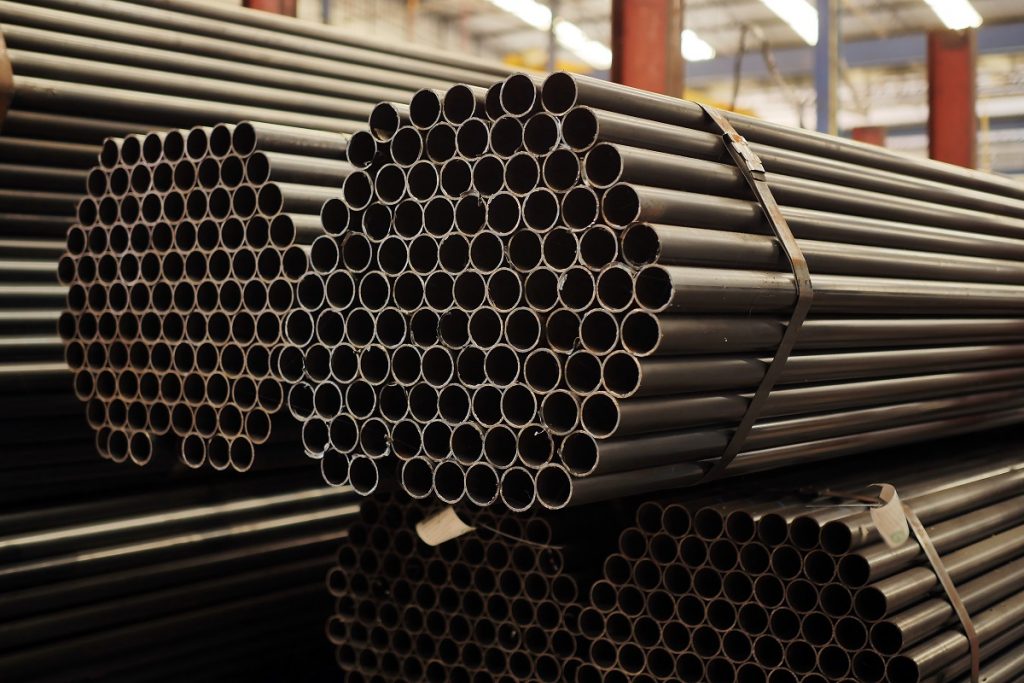How are ERW pipes created?
- Cold-forming
- Passage of current
- Forming
- Welding
- Sizing and cutting
Pipes are some of the most widely-used construction materials. They need to be durable in order to withstand different environmental changes that may cause a drastic change in pressure or temperature. As such, many manufacturing techniques exist in order to achieve industrial-grade pipes. The process of creating ERW steel pipes is one of these techniques. Doubling down on the many properties of steel, ERW pipes offer high strength and durability for fluid transmission and other structural applications.
What is ERW?
ERW stands for electric resistance welding and it is primarily used to describe a specific method in pipe manufacturing. In this process, two uncoiled rolls of steel sheets are joined together without the need for a welding filler wire or metal. Instead, the sheets are combined through the passage of an electrical current and a constant applied force. Unlike what you may notice across other methods of pipe fabrication, ERW pipe-making does not start out with a billet that is rolled before being further refined by a piercer point. Continue reading to learn more.
Cold-forming
Cold-forming is a method of working or forging a metal specimen — in this case, steel — usually in a room temperature environment. This means that the forging takes place below the steel’s recrystallization temperature, helping to remove the impurities from the material. When this occurs, the grain structuring of steel is transformed to become finer and less-coarse, therefore resulting in a hardened material with very little waste found in the machining process.
This is one of the main stages in the creation of ERW pipes. A sheet of steel is cold-rolled or formed into a cylindrical shape. With the absence of further heat-processing techniques, cold-forming is much faster and is suitable for high-speed production. The permanent hardening of the cold-forming process already results in a much stronger steel specimen before the welding stage takes place.
Passage of current
ERW pipe forming is an ongoing process that takes place in a constantly-moving machine. Though this is the case, the many stages that comprise it can still be identified and defined. After the cold-forming process, there is a passage of electrical current between the resulting edges of the cylindrical steel. They are gradually joined together through the current with the help of an induction coil, and a smooth pressure roll to maintain the cylindrical shaping.
The use of an induction coil creates a non-contact method of heating the material. It is typically installed around the steel specimen which is subject to the induction. To control the amount of electrical current that’s distributed throughout the material, an impeder is also added to the ERW machining process. This means that the energy is refocused towards welding the joints of the steel.
Forming
Forming is another process that takes place in ERW manufacturing. The steel coils that pass through the ERW-making machine, as mentioned before, result in cylindrical-shaped sheets that need to be welded by way of electrical current. To better illustrate this, the sheets first appear to be U-shape in appearance, that have several open welded joints, or edges, as they’re called.
All throughout the process, the machine ensures that the resulting U-shaped steel retains this formation in order to avoid defects and irregularities in the fabrication of the ERW pipe. The steel sheet first passes through rolling components before being subject to gage forming, resulting in a uniformed U-shaped cross-section.
Welding
If you’ve ever encountered seamless and non-seamless pipes before, then it’s easy to spot where the manufacturing techniques begin to differ, once they’re compared with ERW pipes. Seamless pipes may appear to be similar in appearance with ERW pipes, but the latter makes use of a non-contact electrical current. No welding takes place in seamless pipes — hence resulting in a continuously-smooth surface that has no visible edges or joints. Seamed pipes, on the other hand, may either make use of a welding filler — something that is not found in the ERW welding process.
Pipe manufacturers always ensure that the welded pipes they’ve made can be suitable for a wide range of uses, such as HVAC systems or petrochemical plants. Despite stringent quality control, it is possible for instances of uneven welding pressure to occur in seamed pipes. Some problems that may take place include pipe leakage or damage that is ultimately far less common across ERW pipes because of their uniform pressure and strength distribution.
Sizing and cutting
After welding the U-shaped joints together, an ERW pipe can now be subject to post-processing techniques to further enhance the properties of the material, as well as its usability.
It’s sized and cut according to specific dimensions, depending on the type of application. With this in mind, ERW pipes can be cut in a wide variety of pipe sizing and lengths that may exhibit differences in the thickness, diameter, or length. To accommodate different fittings, it may also be possible for the pipe ends to be further shaped with an end-facing machine.
Key Takeaway
The process of creating ERW steel pipes are distinct, in that it makes use of an electrical current to weld the joints in place. In this technique, instead of having to use a welding filler to join the edges together, a non-contact induction coil is used with the help of an impeder to concentrate the current to the edges of the pipe.
ERW pipes are far more durable and stronger compared to welded pipes, largely due to the smoother finish. This creates an even distribution of pressure and temperature, especially for HVAC applications, or may also lead to a more consistent transmission of fluids, preventing instances of bursting or leakages.
